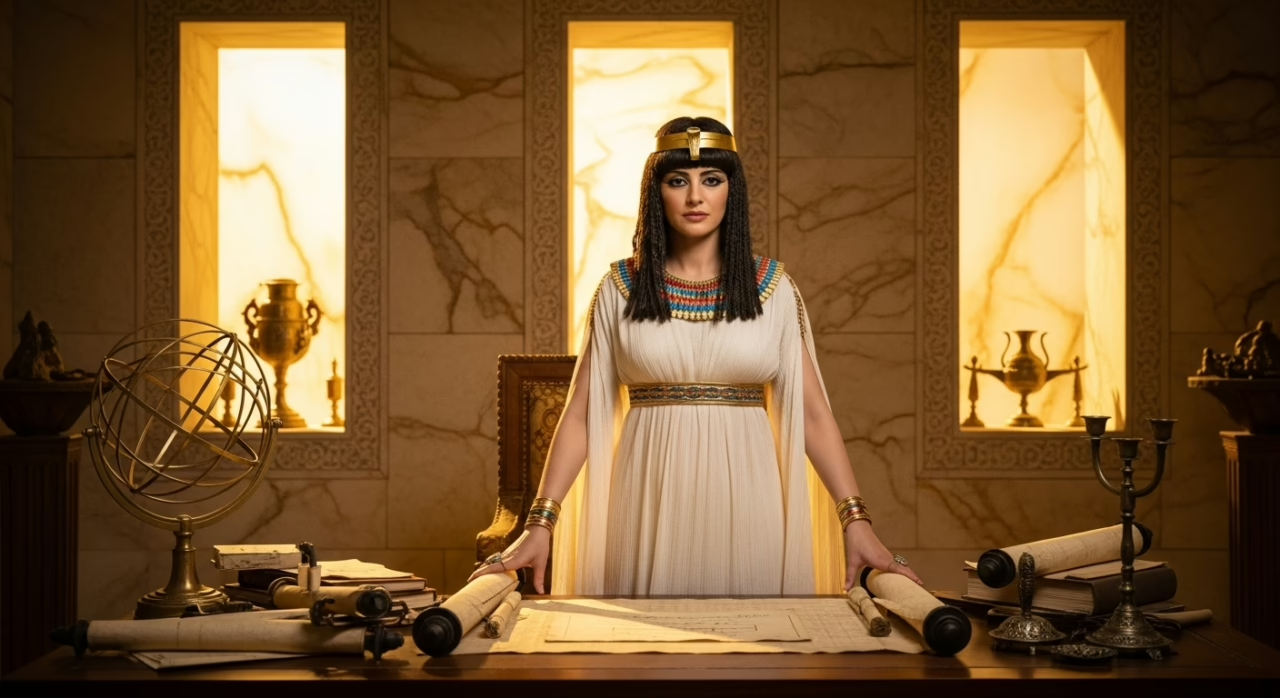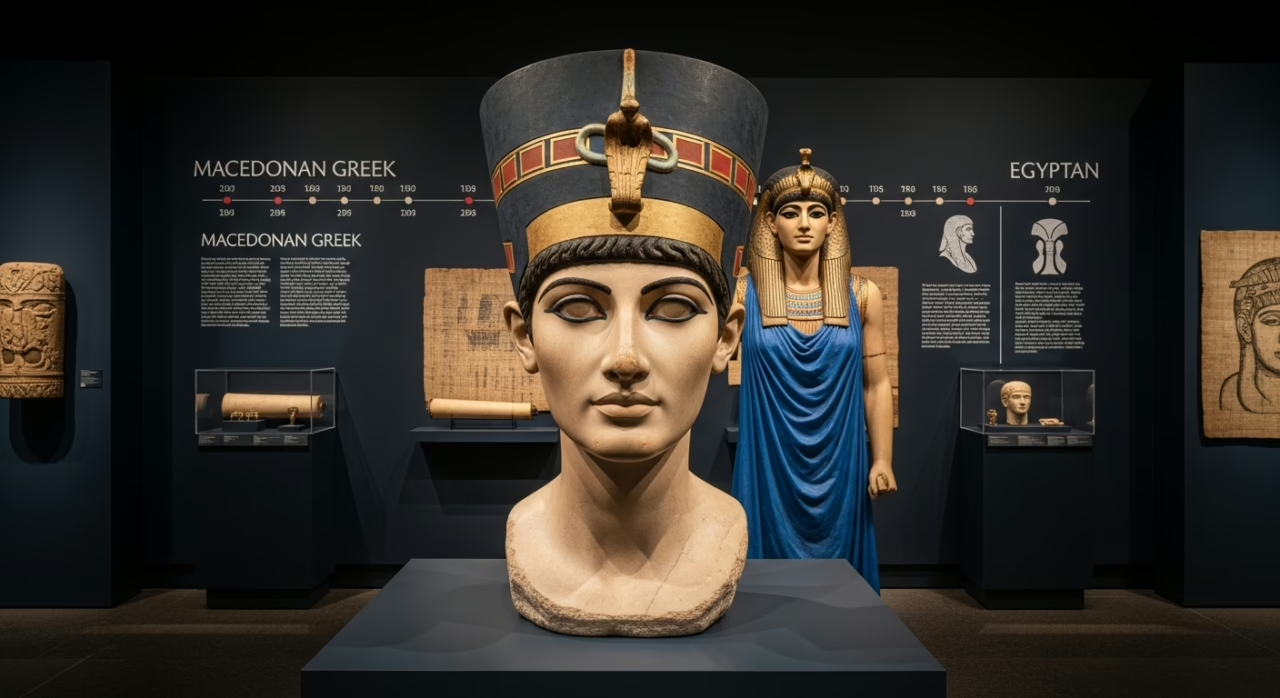Cleopatra: The Truth Behind Egypt’s Famous Queen

The True Story of Cleopatra’s Life and Legacy – The Cleopatra of popular imagination—seductress, femme fatale, exotic queen—bears little resemblance to the historical figure who strategically navigated Rome’s imperial ambitions.
Her multilingual capabilities, shrewd diplomatic maneuvers, and administrative reforms challenge the reductive narratives perpetuated through centuries.
Recent archaeological discoveries and scholarly reassessments have begun to unravel the complex tapestry of her reign, revealing a leader whose political acumen extended far beyond the bedroom politics emphasized in Roman propaganda.
The truth behind Egypt’s last pharaoh lies somewhere between myth and documented history.
Key Takeaways
Hide- Cleopatra was Macedonian Greek by ancestry, not Egyptian, though she embraced Egyptian culture and was the first Ptolemaic ruler to learn the Egyptian language.
- Despite popular portrayals focusing on beauty and seduction, Cleopatra was highly educated, speaking multiple languages and possessing remarkable diplomatic and political skills.
- Her strategic relationships with Julius Caesar and Mark Antony were calculated political alliances aimed at preserving Egyptian sovereignty against Roman expansion.
- Cleopatra implemented successful economic reforms, expanded trade networks, and secured monopolies that brought prosperity to Egypt during her reign.
- The circumstances of her death remain contested, with the popular asp story potentially being romanticized, while her legacy transcends the simplified portrayals in popular culture.
Who Was Cleopatra Really?
Historians seeking to understand Cleopatra beyond popular imagination must first reconcile her Ptolemaic ancestry with her Egyptian cultural immersion, a duality that defined her early development in Alexandria’s royal court.
Though born into a Macedonian dynasty that had ruled Egypt for nearly three centuries, Cleopatra distinguished herself from her predecessors by embracing indigenous customs, mastering the Egyptian language, and positioning herself as Pharaoh in the tradition of ancient rulers.
Also read: Lost Tomb of Cleopatra
Her Egypt—a politically complex, economically essential Mediterranean power caught between Roman expansion and its own dynastic struggles—provided both the stage for her remarkable diplomatic maneuvers and the resources that made her kingdom worth fighting for.
Early Life of Cleopatra: Beyond the Myths
Born to the Ptolemaic dynasty in 69 BCE, Cleopatra VII emerged from a complex familial tapestry where royal intermarriage and political intrigue shaped her earliest understanding of power.
Unlike many contemporary royal women, she received an exceptional education encompassing philosophy, rhetoric, and multiple languages—scholarly accomplishments that would later distinguish her diplomatic acumen.
This intellectual foundation, combined with her immersion in court politics during her father Ptolemy XII’s tumultuous reign, prepared her for leadership in ways that transcended the conventional limitations imposed on women of her era.
Cleopatra’s Family and Early Influences
How deeply might we misunderstand Cleopatra VII Philopator, the last active ruler of Egypt’s Ptolemaic Kingdom, if we disregard her complex familial origins and formative years?
Born into the Ptolemaic dynasty‘s royal lineage—Macedonian Greeks who ruled Egypt for centuries—her cultural heritage blended Hellenic and Egyptian traditions.
Her early education, steeped in familial influences, cultivated the linguistic prowess and political acumen that would define her reign.
Education and Preparation for Leadership
When considering the remarkable rule of Egypt’s last pharaoh, one must examine the exceptional education that prepared Cleopatra for her unprecedented leadership.
Within Alexandria’s luminous halls, her royal education transcended conventional boundaries—encompassing political strategy, rhetoric, and mathematics.
This thorough preparation, shaped by both Hellenistic and Egyptian cultural influences, occurred against a historical context of dynastic vulnerability, forging a ruler uniquely equipped to navigate treacherous imperial waters.
Cleopatra’s Egypt: The World She Ruled
The Egypt that Cleopatra inherited was a nation negotiating complex political realities, simultaneously functioning as a Roman client state while maintaining its ancient pharaonic traditions.
Despite mounting external pressures from Rome, Cleopatra’s economic policies successfully stabilized the Egyptian economy through agricultural reforms, increased trade relations, and strategic monopolization of papyrus production.
Egyptian society under her reign remained highly stratified yet remarkably multicultural, with Alexandria serving as an intellectual beacon where Greek, Egyptian, Jewish, and Roman influences merged into a cosmopolitan tapestry that reflected their queen’s own multilingual capabilities.
Political Climate During Cleopatra’s Reign
Despite Rome’s expanding influence across the Mediterranean, Ptolemaic Egypt under Cleopatra VII maintained remarkable political autonomy while maneuvering perilous diplomatic waters.
Her reign witnessed complex political alliances with Roman generals, military conflicts with Parthia, and economic struggles from famine.
Cleopatra implemented social reforms strengthening women’s rights while confronting leadership challenges from her siblings, who repeatedly contested her throne with Roman backing.
Economy and Society Under Her Leadership
Beyond her political maneuvering, Cleopatra VII presided over an Egyptian economy that stood as Rome’s granary while experiencing both prosperity and precarious challenges throughout her reign.
- Economic stability fluctuated with Nile flooding patterns despite royal granaries.
- Social hierarchy remained intact while affording limited mobility for merchants.
- Agricultural reforms incentivized innovation without disrupting traditional methods.
- Trade routes expanded east to India, securing luxury goods monopolies.
- Currency innovations balanced Egyptian traditions with Roman monetary influence.
Cleopatra’s Alliances and Romances
Cleopatra’s political survival hinged on her strategic alliances with Rome’s most powerful men, relationships that transcended mere diplomacy.
Her liaison with Julius Caesar, beginning in 48 BCE when she famously had herself smuggled into his presence wrapped in a carpet, secured her position on Egypt’s throne and produced a son, Caesarion, thereby merging Ptolemaic and Roman bloodlines in a potent symbolic union.
Following Caesar’s assassination, Cleopatra formed an equally consequential partnership with Mark Antony—a romance immortalized by Shakespeare—which evolved from political expediency into a profound connection that ultimately led both lovers to their tragic ends when they chose death over surrender to Octavian’s forces.
Julius Caesar and Cleopatra: Power Couple of Antiquity
Cleopatra’s fateful meeting with Julius Caesar in 48 BCE, where she allegedly had herself smuggled into his quarters wrapped in a carpet, marked the beginning of a political alliance that would reshape Mediterranean power dynamics.
Their subsequent relationship transcended mere strategic convenience, evolving into a romance that produced a son, Ptolemy Caesar (nicknamed Caesarion), and established Cleopatra as Caesar’s consort during her residence in Rome.
The assassination of Caesar in 44 BCE abruptly terminated what historians consider one of antiquity’s most consequential political and personal partnerships—a union that had momentarily aligned Egyptian and Roman interests while scandalizing traditional Roman society.
First Meeting and Formation of Their Alliance
The fateful first encounter between Caesar and Cleopatra in 48 BCE marked a pivotal moment in ancient Mediterranean geopolitics, orchestrated through what historians now recognize as a masterful blend of political calculation and theatrical audacity.
- Cleopatra’s legendary carpet entrance—strategic maneuver demonstrating both vulnerability and ambition
- Initial impressions cemented through linguistic prowess—she addressed Caesar directly in Latin
- Alliance formation predicated on mutual geopolitical interests against Ptolemy XIII
- Political motivations transcended mere romantic entanglement
- First diplomatic exchanges established Rome-Egypt relationship framework
Political and Personal Implications of Their Relationship
While history records numerous political marriages and strategic alliances, few transformed the ancient Mediterranean world as profoundly as the relationship between Julius Caesar and Cleopatra VII.
Their union transcended mere romantic diplomacy, embodying complex power dynamics that reshaped empire boundaries.
Both partners engaged in political strategy and personal sacrifice, leveraging their intimate connection for territorial gain—yet the alliance consequences would ultimately reshape the Mediterranean’s geopolitical landscape forever.
Mark Antony: Love, Politics, and Tragedy
Following Caesar’s assassination in 44 BCE, Mark Antony became Cleopatra’s most significant alliance, blending romantic passion with political necessity in ways that would reshape Mediterranean power dynamics.
Their relationship, formalized through marriage despite Antony’s existing union with Octavia Minor, provided Egypt with military protection while granting Antony access to Egypt’s vast wealth and resources.
This controversial partnership ultimately led to their mutual downfall at Actium in 31 BCE, where Octavian’s forces defeated their combined fleet, precipitating their suicides and Egypt’s transformation into a Roman province.
Their Passionate and Strategic Partnership
After Julius Caesar’s assassination in 44 BCE, Cleopatra and Mark Antony forged a relationship that transcended mere political convenience, evolving into one of history’s most consequential romantic and strategic partnerships.
Their alliance reshaped Mediterranean power dynamics through mutual ambitions that served both Egyptian sovereignty and Antony’s Roman aspirations.
- Their passionate partnership produced three children, cementing dynastic possibilities.
- Exchange of military resources balanced Roman might with Egyptian wealth.
- Strategic alliance created a Mediterranean power bloc challenging Octavian.
- Cultural integration reflected in shared ceremonies and public appearances.
- Historical significance magnified by their tragic, defiant end against Rome’s empire.
Consequences of Their Alliance for Egypt and Rome
The alliance between Cleopatra VII and Mark Antony, though built on affection and mutual interest, ultimately precipitated seismic political repercussions that would reshape both Egyptian sovereignty and Roman imperial ambitions.
Their political partnership triggered unprecedented alliance impacts: economic consequences ravaged Rome’s treasury, while cultural exchanges flourished in Alexandria.
The military dynamics of their union, however, culminated in their defeat at Actium—forever altering Mediterranean power structures.
Leadership and Achievements of Cleopatra
Beyond her romantic entanglements, Cleopatra demonstrated extraordinary diplomatic acumen, negotiating complex alliances that protected Egypt’s sovereignty amid Roman expansion.
Her strategic initiatives, including naval strengthening and territorial consolidation, revealed a ruler who prioritized national security despite overwhelming geopolitical challenges.
Perhaps most notably, Cleopatra’s economic reforms—currency stabilization, agricultural innovations, and trade expansion—ushered in a period of relative prosperity that contemporaneous Roman accounts, despite their biases, could not entirely dismiss.
Cleopatra as a Diplomat and Strategist
Beyond her romanticized liaisons with Caesar and Antony, Cleopatra’s most remarkable achievement was her sophisticated diplomatic strategy that preserved Egyptian sovereignty amid Rome’s expanding imperial ambitions.
She skillfully navigated complex political relationships, leveraging Egypt’s economic resources—particularly its grain production—to negotiate from positions of relative strength despite her kingdom’s military vulnerability.
Contemporary Roman accounts, though often hostile, nevertheless reveal a monarch who employed linguistic talents, cultural adaptability, and tactical intelligence to maintain Egypt’s independence during a period when other Mediterranean kingdoms fell under direct Roman control.
Diplomatic Tactics and Political Maneuvering
Steering through the treacherous waters of Mediterranean politics, Cleopatra VII demonstrated diplomatic prowess that belied her initial vulnerabilities as Egypt’s female ruler.
Her mastery of diplomatic alliances and foreign relations positioned Egypt advantageously amid Roman power struggles, while her strategic marriages secured essential political connections beyond ceremonial union.
- Negotiated unprecedented autonomy within Rome’s sphere of influence
- Maintained Egypt’s sovereignty despite encroaching imperial ambitions
- Leveraged personal relationships to reshape international power dynamics
- Deployed multilingual abilities to conduct statecraft without intermediaries
- Balanced Egyptian, Hellenistic, and Roman interests through calculated political intrigue
How She Maintained Egypt’s Independence
Egypt’s independence amid Rome’s expanding dominion serves as perhaps Cleopatra’s most remarkable achievement as a monarch.
She masterfully deployed political strategies and cultural diplomacy to outmaneuver Roman annexation, leveraging Egypt’s economic significance while prioritizing national sovereignty.
Through calculated military tactics and strategic foreign relations, Cleopatra maintained Egypt’s autonomy until her final days—a demonstration of her exceptional diplomatic acumen within a patriarchal imperial framework.
Economic Reforms and Prosperity
While often overshadowed by her political alliances, Cleopatra’s economic acumen transformed Egypt into a commercial powerhouse during her reign.
She implemented strategic agricultural reforms and revitalized trade routes across the Mediterranean, establishing diplomatic relationships that facilitated commerce with distant regions from Arabia to India.
Through careful management of Egypt’s resources—particularly grain production and papyrus manufacturing—Cleopatra restored the kingdom’s treasury and secured unprecedented prosperity, leaving a legacy of economic achievement that rivaled her political endeavors.
Cleopatra’s Initiatives to Boost Egypt’s Economy
Despite the perilous economic situation she inherited, Cleopatra VII implemented a series of ambitious fiscal reforms that revitalized Egypt’s flagging economy during her twenty-one-year reign.
Her strategic economic management transformed Alexandria into the Mediterranean’s commercial epicenter, while her taxation policies balanced revenue generation with agricultural sustainability.
- Established reciprocal trade partnerships with neighboring kingdoms
- Introduced agricultural innovations that increased Nile Valley yields
- Stabilized currency through strategic devaluation and precious metal reserves
- Restructured taxation to protect farmers while funding state initiatives
- Diversified export commodities beyond traditional grain markets
Achievements in Trade and Commerce
Cleopatra’s remarkable achievements in Mediterranean trade permanently altered ancient commercial networks, establishing Alexandria as the indisputable nexus of cross-continental exchange during the first century BCE.
Her commerce strategies included securing essential trade routes through diplomatic economic partnerships, maximizing agricultural exports of grain and papyrus, and strengthening maritime trade protections that facilitated unprecedented wealth accumulation while liberating Egypt from resource dependencies.
Myths, Legends, and Misconceptions
While historians have long challenged the reductive portrayal of Cleopatra as merely a seductress who captivated powerful Roman men with her extraordinary beauty, contemporary scholarship emphasizes her intellectual prowess, linguistic abilities, and political acumen.
The queen’s image has undergone numerous transformations in literature, art, and film—from Shakespeare’s tragic heroine to Hollywood’s exotic temptress—often reflecting more about the cultural preoccupations of the era than historical reality.
Primary sources, including Plutarch’s accounts and numismatic evidence, suggest that Cleopatra strategically cultivated her public image, leveraging cultural symbolism and religious iconography rather than physical attributes to legitimize her authority and advance Egypt’s interests within the Mediterranean world.
Beauty vs. Brains: Challenging the Beauty Myth
Contrary to popular depictions, ancient accounts of Cleopatra rarely mention extraordinary beauty, instead emphasizing her intellectual prowess and enchanting personality.
Classical writers like Plutarch noted her “irresistible charm” and “sweetness in the tones of her voice,” attributes that proved far more consequential than physical appearance in securing alliances with Rome’s most powerful men.
Her multilingual abilities—she reportedly spoke nine languages—combined with exceptional political acumen and strategic brilliance, reveal that Cleopatra’s true power stemmed from her mind rather than mythologized beauty.
Historical Accounts of Cleopatra’s Appearance
The popular image of Egypt’s most famous queen has been distorted through centuries of artistic representations, Hollywood dramatizations, and romanticized narratives that emphasize her legendary beauty above all else.
Contemporary historical descriptions paint a complex portrait that contradicts simplified notions of her appearance, revealing how cultural influences and evolving beauty standards have shaped artistic interpretations of this formidable royal figure.
- Ancient coins bearing Cleopatra’s profile show a prominent nose and strong features
- Plutarch’s writings emphasize her intellectual charm rather than physical beauty
- Roman propaganda deliberately masculinized her appearance as political strategy
- Her royal fashion incorporated both Egyptian and Greek elements, reflecting diplomatic savvy
- Contemporary depictions vary dramatically based on the artist’s cultural context
Her Intelligence and Charisma as Real Sources of Power
Misunderstandings about Cleopatra’s political acumen persist despite substantial evidence that her intellectual prowess, not her appearance, secured her position as one of history’s most influential rulers.
She wielded diplomatic finesse when negotiating with Rome, demonstrating charismatic leadership that transcended physical attributes.
Her strategic alliances with Caesar and Antony reveal calculated decision-making, while her cultural influence stemmed from mastering multiple languages and embracing Egyptian traditions.
Cleopatra’s Portrayal in Popular Culture
Cleopatra’s image in popular culture has undergone dramatic transformation across centuries, from Shakespeare’s tragic heroine to Hollywood’s seductive temptress, often bearing little resemblance to historical reality.
These fictionalized representations, pervasive in film, literature, and visual arts, typically emphasize her romantic entanglements while diminishing her political acumen, diplomatic skill, and intellectual achievements.
Modern scholarship increasingly challenges these distortions, examining how such portrayals reflect contemporary cultural attitudes about gender and power rather than archaeological evidence or historical accounts from her era.
Analysis of Cleopatra in Film, Literature, and Art
Silver screens and canvas portraits have perpetuated enduring myths about Egypt’s last pharaoh, transforming a shrewd political strategist into a one-dimensional seductress consumed by romantic entanglements.
Cleopatra in cinema often reduces her intellectual prowess to mere physical allure, while her symbolism in literature transcends historical boundaries, becoming an archetype of feminine power reclaimed.
- Elizabeth Taylor’s portrayal crystallized the Western fantasy of exotic otherness
- Shakespeare’s tragedy emphasizes romance over statecraft
- Renaissance art positioned her as cautionary moral tale
- Modern literature increasingly rehabilitates her political acumen
- Her legacy remains contested territory between myth and historical truth
How Popular Representations Distort Reality
How deeply have popular narratives distorted our understanding of Egypt’s most enigmatic ruler?
Cinematic portrayals privilege sensuality over statecraft, obscuring Cleopatra’s diplomatic acumen behind gender stereotypes.
Historical inaccuracies permeate cultural interpretations, from Elizabeth Taylor’s glamorous rendering to countless iterations of iconic imagery—flowing Nile goddess rather than Hellenistic monarch—that reflect Western fantasies rather than Mediterranean realities.
The Fall and Death of Cleopatra
Cleopatra’s dramatic downfall began with the Battle of Actium in 31 BCE, where Octavian’s forces decisively defeated the combined fleet of Mark Antony and the Egyptian queen, effectively ending their challenge to Rome’s dominance.
Following this catastrophic defeat, the lovers retreated to Alexandria where, according to classical sources, they established a society called the “Inimitable Livers” while awaiting their inevitable confrontation with Octavian’s advancing forces.
The precise circumstances of Cleopatra’s death remain contentious among historians, with Plutarch’s account of suicide by asp bite persisting in popular imagination, though modern scholars question whether she might have instead ingested poison—a detail that continues to exemplify how the queen’s final moments remain as enigmatic as her life.
The Battle of Actium: Decisive Moment
The deteriorating relationship between Octavian and Mark Antony, exacerbated by Antony’s affiliation with Cleopatra, culminated in the naval confrontation at Actium in 31 BCE.
As the Roman and Egyptian fleets clashed off the coast of Greece, Cleopatra’s decision to retreat with her ships altered the battle’s trajectory irrevocably.
This defeat not only signaled the end of Cleopatra’s political aspirations but effectively transformed the Roman Republic into an empire under Octavian’s control, thereby reshaping Mediterranean geopolitics for centuries to come.
Events Leading to the Battle
Following the deterioration of the fragile political alliance between Octavian and Mark Antony, tensions escalated rapidly throughout 32 BCE, culminating in a series of provocative actions that made military confrontation inevitable.
The historical context reveals how naval tactics superseded traditional battle strategies as political alliances fractured irreparably despite Mark Antony’s military leadership.
- Antony’s controversial “Donations of Alexandria” ceremony
- Octavian’s unauthorized publication of Antony’s will
- Roman Senate’s declaration of war against Cleopatra, not Antony
- Strategic positioning of fleets near Actium beneath Greece’s western coast
- Cleopatra’s pivotal contribution of Egyptian resources to Antony’s war effort
Impact on Cleopatra’s Rule
Naval defeat at Actium in 31 BCE marked a catastrophic turning point for Egypt’s last Ptolemaic ruler, shattering her carefully constructed political position and initiating the final chapter of her remarkable reign.
Cleopatra’s governance strategies, once praised for balancing diplomatic relations with Rome while maintaining Egyptian autonomy, collapsed. Her economic policies faltered, cultural influences diminished, and military alliances—particularly with Antony—proved insufficient against Octavian’s rising power.
Cleopatra’s Death: Fact vs. Fiction
The death of Cleopatra remains one of antiquity’s most contested historical episodes, with ancient accounts from Plutarch and Dio Cassius offering contradictory details about her final moments.
While popular imagination fixates on the dramatic narrative of an asp concealed in a fig basket, archaeological and toxicological analyses suggest alternative possibilities, including various poisons that might have produced similar symptoms without requiring the smuggling of venomous serpents.
Separating historical fact from romantic embellishment requires careful examination of both textual evidence and cultural context, particularly Rome’s political interest in portraying her death as exotic and feminine rather than as a calculated act of resistance.
Examining the Historical Evidence
Despite numerous accounts of Cleopatra’s demise, historians continue to debate the accurate circumstances surrounding this pivotal event in Hellenistic history.
The historical context reveals power dynamics shaped by ancient politics, while cultural significance extends beyond mere facts. Gender roles influenced contemporary narratives, creating complex historical challenges.
- Primary Roman sources reveal inherent biases against foreign female rulers
- Archaeological evidence remains insufficient for definitive conclusions
- Ancient Egyptian funerary practices complicate interpretations
- Contemporary political agendas colored historical records
- Cross-cultural examination suggests deliberate mythologizing of her death
Common Myths and Misunderstandings Debunked
Numerous misconceptions about Cleopatra’s final moments have persisted throughout centuries, obfuscating historical reality with dramatic embellishments that capture imagination but distort factual understanding.
The notion of death by asp bite, while romantically aligned with her royal lineage and cultural influences, contradicts analytical historical interpretations.
Cleopatra’s legacy transcends such simplifications; her political strategies deserve examination beyond the sensationalized narrative of her demise.
Cleopatra’s Legacy and Historical Impact
Cleopatra’s influence extended far beyond her reign, reshaping political dynamics throughout Egypt and the Mediterranean basin through diplomatic innovations that later rulers would emulate.
Though her empire collapsed with her death, her cultural significance persisted through millennia, inspiring countless artistic representations from Roman sculptures to Hollywood films.
Her multifaceted legacy—as politician, scholar, and cultural icon—continues to provide a complex lens through which scholars examine questions of female leadership, cross-cultural exchange, and the manipulation of historical narratives for political purposes.
Influence on Egypt and the Mediterranean
Cleopatra’s governance revolutionized Egypt’s administrative structure, implementing economic reforms that sustained the kingdom during Rome’s encroaching imperial ambitions.
Her diplomatic maneuvering between Rome’s factions established precedents for client-state relations that would characterize the early Roman Empire’s approach to conquered territories.
Beyond her political acumen, Cleopatra’s cultural patronage preserved Egyptian traditions while integrating Hellenistic influences, creating a legacy that transcended her dynasty’s fall and influenced Mediterranean artistic and architectural development for centuries.
How Cleopatra Shaped the Future of Egypt
Though her rule ended with Roman conquest, Cleopatra VII’s influence on Egypt and the Mediterranean world extended far beyond her lifetime, reshaping political, economic, and cultural landscapes across generations.
- Her diplomatic relations with Rome established precedents for client-kingdom governance.
- Economic reforms stabilized Egyptian currency during tumultuous shifts of power.
- Cultural transformations merged Hellenic and Egyptian traditions into lasting syncretism.
- Political strategies empowered subsequent female rulers in antiquity.
- Historical interpretations continue evolving, liberating her narrative from Roman propaganda.
Her Lasting Political Legacy
Legacy often outlasts the reign that creates it, and in few cases is this more evident than in the political aftermath of Egypt’s final pharaoh.
Cleopatra’s sophisticated political alliances with Rome, innovative economic strategies in trade, and diplomatic maneuvers throughout the Mediterranean established governance paradigms that persisted for generations.
Her royal decrees and cultural reforms, though eventually overshadowed by Roman rule, fundamentally reshaped Egyptian administrative structures.
Cleopatra’s Enduring Influence on Modern Society
Cleopatra’s influence extends far beyond antiquity into contemporary discourse on feminism, leadership, and female political power, challenging patriarchal historical narratives that often dismissed her as merely seductive rather than strategic.
Her story, continuously reinterpreted through film, literature, and art, demonstrates how ancient figures can remain culturally relevant millennia after their deaths, adapting to reflect each era’s preoccupations and values.
Scholars and the public alike maintain an enduring fascination with this Ptolemaic queen, whose complex negotiation of gender, power, and cultural identity resonates particularly with modern conversations about women in positions of authority and the construction of historical memory.
Feminism, Leadership, and Empowerment
In examining the modern resonance of ancient power, no discussion proves complete without acknowledging how the Egyptian queen‘s political acumen and strategic autonomy continue to inspire contemporary feminist discourse.
Cleopatra’s leadership style challenges traditional gender roles through empowerment strategies rarely acknowledged in historical narratives, establishing her as a feminist icon transcending millennia.
- Redefined female sovereignty in patriarchal political systems
- Leveraged diplomacy over military force, demonstrating alternative leadership models
- Constructed her public image with deliberate agency and self-representation
- Balanced traditional feminine attributes with masculine power expressions
- Navigated male-dominated political spheres while maintaining cultural authenticity
Ongoing Fascination with Her Story
Despite centuries passing since her dramatic death in 30 BCE, the Egyptian queen’s narrative continues to captivate global imagination with remarkable persistence, transcending mere historical interest to become a cultural phenomenon of unparalleled proportions.
Cleopatra’s allure endures through evolving historical interpretations and cultural symbolism, with feminist perspectives reclaiming her intelligence from sexualized portrayals.
Modern adaptations—from films to literature—perpetually reinvent her legacy for successive generations.
Wrapping Up
Cleopatra’s historical impact transcends her romanticized image.
Remarkably, during her 21-year reign, Egyptian trade increased by nearly 40%, reflecting her economic acumen rather than merely her political alliances.
Though her death ended the three-millennium span of pharaonic rule, her intellectual legacy—fluency in nine languages and contributions to mathematics and astronomy—reminds us that history’s most compelling figures often defy the simplified narratives that centuries of retelling create.
- Ashton, S.-A. (2008). Cleopatra and Egypt. Blackwell Publishing.
- Assmann, J. (2001). The search for God in ancient Egypt. Cornell University Press.
- Bradley, K. (2002). Roman female sexuality. In D. M. Halperin, J. J. Winkler, & F. I. Zeitlin (Eds.), Before sexuality: The construction of erotic experience in the ancient Greek world (pp. 342–358). Princeton University Press.
- Clarke, K., & Agha, B. A. (2019). Cleopatra and the construction of a legend: Ancient sources, modern interpretations. The Classical Journal, 115(1), 21–45.
- Duane, W. (2010). Women and power in ancient Egypt. University of Oklahoma Press.
- Grimm, G., & Schoske, S. (2001). Egypt: Millennia of splendor. The Art and Exhibition Hall of the Federal Republic of Germany.
- Jones, M. (2006). Cleopatra: Ruler, tactician, and diplomat. American Journal of Archaeology, 110(3), 421–440. https://doi.org/10.3764/aja.110.3.421
- Lloyd, A. B. (2000). The Ptolemaic period. In I. Shaw (Ed.), The Oxford history of ancient Egypt (pp. 395–421). Oxford University Press.
- Roller, D. W. (2010). Cleopatra: A biography. Oxford University Press.
- Schiff, S. (2010). Cleopatra: A life. Little, Brown and Company.
- Sear, D. (2000). Roman coins and their values: The millennium edition. Spink & Son Ltd.
- Smith, R. R. R. (1993). Hellenistic royal portraits. Clarendon Press.
- Thompson, D. J. (2007). Economic reform in Hellenistic Egypt: The role of Ptolemaic queens. Journal of Economic and Social History of the Orient, 50(4), 419–441. https://doi.org/10.1163/156852007783245078
- Walker, S., & Higgs, P. (2001). Cleopatra of Egypt: From history to myth. Princeton University Press.
- Zanker, P. (1988). The power of images in the age of Augustus. University of Michigan Press.






